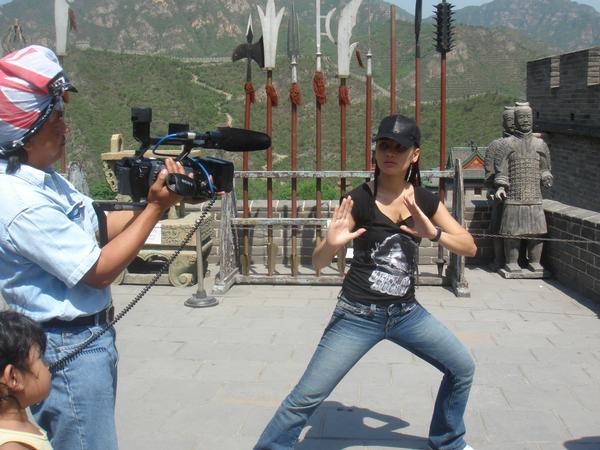

The subject of al-Mahdi (A.S.)is not restricted to the school of the Ahl al-Bayt, peace be upon them, rather, it is an object of interest for all Muslim schools of thought. Many great Muslim scholars urged by the numerous traditions related from the Prophet of Islam have investigated this subject and have written many books on it.
Muslim mystics, based on the existing traditions and their special views on existence and creation, have treated the question of al-Mahdi (A.S.)from their own particular perspective. Monotheism and knowing the Perfect Man, who is the true monotheist, are the very foundations of all questions and knowledge for the mystic. From the viewpoint of the great sages among the people of intuition, the Perfect Man is the bezel in the ring of the order of creation and the preservation of the world and mankind are dependent upon his existence.
The People of Meaning assert that the Perfect Man should also have an elemental existence throughout the ages so that the world and man are maintained in the light of his being. They have spoken of such a man on different occasions and under different names.
The great mystic Aziz al-Din Nasafi, in his book Al-Insan al-Kamil (‘The Perfect Man’), writes: “Now know that this Perfect Man has many names, including Hadi (the guide), al-Mahdi, Imam, Caliph (or Khalifah, successor), and Sahib al-Zaman (Lord of the Time).” He further adds:
"This Perfect Man has always existed in the world, and He is no more than one. For, if we take all the beings of the world as one person, the Perfect Man will be the heart of that person, and a creature without a heart cannot live. Therefore, the Perfect Man always exists in the world, and He cannot be more than one."
Muhyi al-Din ibn Arabi also in ‘The Bezel of Adam’ holds that caliphate is confined to the Perfect Man, and states that “Succession (khilafat) cannot be true except for the Perfect Man.” Of course, it must be noted that from the viewpoint of the mystics, the ‘Qutb’ (the Pole) in the world of existence is like the spirit in the body, and ‘Hadi’ and Mahdi bear the same meaning of the ‘Qutb’.
Sheikh 'Ali Akbar ibn Asad Allah ibn 'Amr Allah al-Mawdudi, a well-known Indian scholar, in his Yawaqit (‘Emeralds’), Question 45, relates that Al-Sharani has said:
"Sheikh Abu al Hasan al-Shadili, may Allah be pleased with him, has said that the ‘Qutb’ or the Perfect Man is described by fifteen signs. These include the fact that he should be characterized by infallibility, mercy and succession, he should strengthen the Carriers of the Throne, and the truth of humility should be revealed to him. He should also be familiar with all the Divine Attributes. Then he explains the foregoing according to what is held by those who believe that other than the Prophet can also be infallible, and that those who confine infallibility to only certain people and deny it to others have strayed from the way.
Imam al-Mahdi (A.S.)from the Viewpoint of Sheikh Muhyi al-Din ibn Arabi Muhyi a1-Din ibn al-Arabi al-Ta’i is a mystic, philosopher and theologian. He was born in Murcia, Andalusia and settled and died in Damascus in 638 A. H. He wrote numerous books, some of which are al-Futuhat al-Makkiyah, Muhadarat al-Abrar, Fusus al-Hikam, al-Tajalliyyat al-Illahiyya, some poetical works and many others.
Muhyi al-Din speaks about the Mahdi in the Futuhat, and on different occasions. In chapter 366, for example, he writes:
Know that al-Mahdi (A.S.)must come, but he will not come until the earth is filled with injustice and oppression. He will fill it with justice and equity. Even if there remains a single day of the world, God will extend that day until that Caliph(successor) comes to Caliphate (ruling as a caliph).
Al-Mahdi (A.S.)is of the progeny of the Messenger of Allah and of the descendants of Fatimah, peace be upon her. His grandfather is al-Husayn ibn 'Ali ibn Abi Talib. His father is al-Hasan al-Askari, the son of Imam 'Ali al-Naqi, the son of Muhammad al-Taqi, the son of Imam 'Ali al-Rida, the son of Imam Musa al-Kadim, the son of Imam Ja‘far al-Sadiq, the son of Imam Muhammad al-Baqir, the son of Imam 'Ali Zayn al-Abidin, the son of Imam al-Husayn, the son of 'Ali ibn Abi Talib, peace be upon him.
His name is the same as the Prophet’s name and the Muslims will pledge allegiance to him between Rukn and Maqam. He is like the Prophet and is similar to him in temperament, for no-one is closer to the unparalleled temperament of the Prophet (“Indeed you possess a great character” al-Qalam: 4) than his eminence Furthermore, Muhyi al-Din in al-Manaqib (‘The Virtues’) speaks of the excellences of al-Mahdi (M.A.H.H.A.):
"Ali is the Secret of the Eminent Secrets, the Hidden Soul of the Holy Souls, the Ladder of the Intellects, the Accomplishment of the Principles, the Pole of the Millstone of the Existence, the Centre of the Circle of the Revelation, the Perfection of the Creation and the Origin of the Perfection, the Beauty of all and the Gathering Place of the Existence, the Known and Existing Knowledge. Questions turn to him, he whose birth is well-known. He is parallel to the Prophetic Mirror, the Verifier of the Appeasing Secrets, the One Embellished by the Divine Lights, and the One Nourished within the Lordly Veils. He emanates truths by his existence, and splits subtleties by his revelation. He is the Greatest Divine Name, containing the Infinite Modes of the Creation, the Endless, the Diver into the Merciful Ocean, the King of Compassionate Bounties, the Mountain of Godly Manifestation, the Fire of the Corporeal Tree, the Law of the great Allah, the Ultimate Goal of mankind, the Father of the master of the Time, the one of who is the Refuge of the Truth, the Organizer of the hidden and known places of order, Abu al-Qasim Muhammad ibn al-Hasan, peace be upon him."
That which has been mentioned here are the attributes, the virtues and the lineage of his eminence as well as a depiction of his government at the time of his appearance. These have been taken from widely transmitted narrations found in the recorded traditions of the Islamic schools of thought. Moreover, ibn Arabi in the second volume of al-Futuhat explains the subject mentioned above in answer to a few questions put by Al-Hakim al-Tirmidi and claims that the Seal of Sainthood (wilayat) is alive and he had the honour to be in his presence.
Of course, ibn Arabi divides the seal of sainthood into the seal of general sainthood and special sainthood. He holds that Jesus (p.b.u.h.) is the Seal of General Sainthood and al-Mahdi(A.S.)is the Seal of Muhammadan Sainthood and of Special Sainthood. In this article I do not intend to criticize his views, therefore, I refer the reader to Sayyid Haydar Amuli’s Jami‘al-Asrar (‘The Compendium of the Secrets’), who, despite his deep respect for ibn Arabi, criticizes the latter’s discourse on sainthood.
There are elegant poems in his book, al-Futuhat al-Makkiyah expressive of his devotion and respect for al-mahdi (A.S.) Sheikh Mahmud Shabistari and Sheikh Muhammad Lahiji Sheikh Mahmud Shabistari is the author of the mystical ode Golshan-e Raz (‘The Rose Garden of the Secrets’). This book is counted as one of the most excellent of mystical books which has guaranteed its author eternal fame. Many commentaries have been written on the poem, of which the commentary of Sheikh Muhammad Lahiji is one of the best.
Lahiji argues that: The Saint (wali) follows and obeys the Prophet both in ease and adversity and in contraction and expansion, and attempts, struggles and shows obedience in the way. Because of this, he is ordered to observe all (the religious) commandments and abstain from all that is forbidden, and in respect of Divine law and spiritual discipline has become who shares secrets with the Prophet. Since the Prophet has attained the rank of the Beloved, so also will the Saint move from the rank of a lover to that of a beloved by carefully following the Prophet. For the attribute of being dearly loved will flow from the Prophet into the Saints because of the latter’s obedience. As well, he will achieve an intimacy with the Prophet, sainthood and close proximity to God. This is as the Messenger of God has said,
“'Ali belongs to me and I belong to him. 'Ali and I have been created from a single light. You ('Ali) are to me as Aaron is to Moses except that there would be no Prophet after me.”
Sheikh Mahmud Shabistari writes: Sainthood assumes various manifestations according to different dispositions and capacities to the extent that they become innumerable… The highest and most perfect manifestation of this sainthood appears in the perfect being of the Seal of the Saints, for he is the manifestation of absolute sainthood, whereas the rest of the saints in their various ranks derive the light of sainthood from the lamp of the Seal of the Saints.
Sheikh Muhammad Lahiji in his commentary on the speech of Mahmud Shabistari writes: The Seal of the Saints is the manifestation of all sainthood. It is the perfection of the community, as the perfection of the reality of the circle is manifested in the last point. The Seal of the Saints is Imam Muhammad al-Mahdi (A.S.)who has been promised by the Prophet, peace be upon him and his Household, who has said,
“Even if there remains only one day of the world, Allah will extend that day until He sends a man from my progeny or from my Household. He will fill the earth with justice and equity as it has been filled with injustice and oppression.” He further states, «المهدي من عترتي من اولاد فاطمة» “Al-Mahdi (A.S.)is from my progeny, and he is of the descendants of Fatimah.”
Within the circle of absolute sainthood, which is manifested by the Seal of the Saints, the saints are all like points or the different limbs of the Seal of the Saints. This is because the reality of sainthood is realised by one of the attributes of perfection in each of the saints, and by all the attributes (manifested) in the last point which is Muhammad al-Mahdi(A.S.)The circle of sainthood is manifested and becomes actualized in this last point. Just as all the Prophets, peace be upon them, derive the light of legislative prophethood from the lamp of the prophethood of the Seal of the Prophets, similarly all the saints derive the light of sainthood and perfection from the sun of the sainthood pertaining to the Seal of the Saints. This is why the sainthood of the Seal of the Saints is called Solar Sainthood while the sainthood of other saints is called Lunar Sainthood. For all saints take the light of their sainthood from the absolute sainthood of the Seal of the Saints as the moon takes its light from the sun.
Abd al-Razzaq al-Qasani in his commentary on the speech of ibn Arabi also writes: It points to the fact that in matters of the religious law the Seal of the Saints must be a follower, just as al-Mahdi (A.S.)who will come at the end of time, is a follower of Muhammad, peace be upon him, in matters of the religious law and in the fields of real knowledge and sciences. All the rophets and Saints would follow him, and this would not contradict what we have said, for his inner being is the inner being of Muhammad, peace be upon him. This is why it is said that he is one of the good deeds of the Lord of the Prophets, peace be upon him, who has said, «ان اسمه اسمي و كنيته كنيتي فله المقام المحمود» “His name is my name and his nickname is my nickname, and he has a praised position.”
He also in Tuhfat al-Ikhwan fi Khasais al-Fityan (‘The Gift of the Brothers on the Characteristics of the Generous) writes: Just as Adam, the Chosen by Allah, is the beginning and manifestation of Prophethood, Abraham, the Friend of Allah, is its Pole, and Muhammad, the Beloved of Allah, is its Seal; so too is Abraham the beginning of the Generosity, 'Ali, the Commander of the Faithful, is its Pole, and Muhammad al-Mahdi, peace be upon him, is its Seal, and he is the Seal of the Saints.
As is clearly seen, in these eloquent words, reference is made to two important points about al-Mahdi (M.A.H.H.A.): first his being the Seal of the Saints, and second his position in relation to all other messengers of God.
Khwajah Muhammad Parsa in Fasl al-Khitab (‘The Distinction of Speech’), says: Because Abu Abd Allah Ja‘far ibn 'Ali al-Hadi, may Allah be pleased with him, thought his brother Abu Muhammad al-Hasan al-Askari had no son, and claimed that his brother has trusted him with the Imamate of the Muslims, he is called ‘the Liar’… Abu Muhammad al-Askari introduced his son Muhammad, may Allah be pleased with both of them, to the trustworthy and the dependable members among his Household and companions.
Then he narrates the tradition of Hakimah, the aunt of Imam al-Askari (p.b.u.h.), about the birth of the Imam of the Time and at the end he states: "Imam al-Askari said to me, "O my aunt! Take this child to his mother." I returned him to his mother. The other day when I came to see Imam al-Askari (p.b.u.h.), I saw the child with him, and he was so bright that he enchanted my heart. I said, "My lord! Do you know this blessed child?" He said, "My aunt! He is the one who should be waited for, he is the one about whose coming we have been given good tidings."
Then Hakimah added: "I fell in prostration and thanked Allah. Then for sometime I used to frequent the Imam’s house, but I did not see him. One day I said to the Imam, “My lord! What did you do with my lord, the Awaited One?” He replied, “We trusted him to That with Whom the mother of Moses trusted her son.”"
He further writes: "The traditions in this regard are countless. The virtues of al-Mahdi(A.S.)the Hidden from the Eyes and the Lord of the Time…are numerous. We have recurrent narrations that he will appear, and the light of his existence will shine everywhere; he will revive the religion of Islam and fight in the way of Allah…. His companions are free from any flaw or defect; they pass their days as he does, and they attain the truth with his guidance. Moreover, the caliphate and sainthood will end with him. He is the Imam from the death of his father to the Day of Resurrection. Jesus will stand behind him in prayers and will confirm his claim; he will call people to his religion, which is the religion of Islam."
Mawla Jami Noor al-Din Abdul Rahman In Shawahid al-Nubuwwah (‘The Evidence of Prophethood’), Jami introduces the Son of al-Hasan al-Askari as the Twelfth Imam; and describing the wonderful events of his birth and some of his miracles, states that he is the One who will fill the world with justice and equity. In this book, at the end of his account of the life of the Infallible Imams, he writes that Muhammad ibn al-Hasan ibn 'Ali ibn Muhammad ibn 'Ali al-Rida, may Allah be pleased with them, is the Twelfth Imam and his nickname is Abu al-Qasim and his titles include the Proof, the Awaited Imam and the Lord of the Time.
‘Arif Abd al-Rahman He is one of the masters of the Sufis and is the author of Miraat al-Asrar (‘The Mirror of the Secrets). As is quoted in Kashf al-Astar (‘Unwrapping the Veils’), he explains his views on the Twelfth Imam, the Promised al-Mahdi (M.A.H.H.A.):
"Here we state that the Sun of the Religion and the Fortune of that Guide of the people and the kingdom, the Pure Successor of Ahmad, the True Imam Abu al-Qasim Muhammad ibn al-Hasan al-Mahdi, may Allah be pleased with him. He is the Twelfth Imam among the Imams of the Household of the Prophet. His mother is (Umm Walad) and her name is Narjis. He was born on Thursday night, the fifteenth of Ramadan, 255 AH, or, according to the version given in Shawahid al-Nubuwwah, on 23rd of Ramadan in Samarra in 258 AH. The name and the agnomen of the Twelfth Imam are the name and agnomen of the Prophet. His sacred titles are al-Mahdi, al-Hujjat (the Proof), al-Qa‘im (the One who Rises), al-Muntadar (the Awaited One), Lord of the Time, and the Twelfth One who Rises. At the time of the death of his father, Imam al-Hasan al-Askari, he was five years old, and he became Imam at that age, just as God the Exalted had given John, son of Zachariah, wisdom and honour during childhood, and elevated Jesus the son of Mary, peace be upon him, to a high rank when he was only a child."
He adds that “His miracles are so many that they cannot be counted in this small space.” Then he refers to a narration which has been related by Mulla Abd al-Rahman al-Jami in Shawahid al-Nubuwwah through Hakimah, the sister of Imam 'Ali al-Naqi, the aunt of Imam al-Hasan al-Askari, and he discusses the birth of his eminence which has been already covered.
Sa‘ad al-Din Muhammad ibn al-Muayyad al-Hamawi He was born in 587 AH and died in 650 AH. He is an Iranian mystic who was widely acclaimed by his contemporaries. Explaining his views on the Guardian, the saints and Imam al-Mahdi(A.S.)he writes:
"And when it was the turn of the religion of Muhammad, he said, "After me there would be no Prophet to call people to my religion. After me there will be those who follow me and are close to God. They are called the Saints. These Saints will call people to my religion." and from that time the term ‘wali’ or ‘guardian’ came to be used in the religion of Muhammad. Allah, the Exalted has chosen twelve persons among the community of Muhammad, brought them close to Him, conferred His special sainthood on them and made them the Successors of Muhammad. The sentence, «العلماء ورثة الأنبياء» “The Scholars are the heirs of the Prophets” has been said in relation to these twelve persons, and, likewise, the statement, «علماء أمتي كأنبياء بني اسرائيل» “The scholars of my community are like the Prophets of the Israelites.” However, the last, who is the Twelfth Guardian, is the Seal of the Saints and is called al-Mahdi(A.S.)and Lord of the Time."
Sheikh Farid al-Din Attar Neishaburi Sheikh Farid al-Din Attar Neishaburi abu Hamid - or Abu Talib- Muhammad, son of Abu Bakr (died in 618 A.H.) is a famous Hanafi mystic. He wrote books both in prose and verse. His Tadhkirat al-Awliya (‘The Biographies of the Saints’), which is about the life-stories of the mystics, is counted as an authentic reference and document, and his Mantiq al-Tayr (‘The Discourse of the Birds’) is a monumental mystical work. In his Madh-har al-Sifat (‘The Manifestation of the Attributes’), he praises the great Prophet of Islam and his Household in verse, and at the end he praises the Lord of the Time.
It is interesting to know that it has been reported that this great man of letters has never praised any of the kings or princes of his time. In fact, one cannot find one piece of writing in all his works praising anybody else. Nevertheless, he has composed this excellent eulogy about the Imams of Shiism (peace be upon all of them). He has also composed other interesting odes in praise of Imam 'Ali, Master of the Virtuous (peace be upon him).
Mawlana Jalal al-Din al-Balkhi Jalal al-Din Muhammad Balkhi al-Rumi, known as Mawlawi (died in 672 A.H.) is a distinguished and great Hanafi mystic and poet. He is the author of the Mathnawi and is thought to be one of the greatest mystics and geniuses of the Muslim world. His Mathnawi is a mine of wisdom and knowledge. His other work, the Diwan-e Shams, contains his odes.
In his Diwan-e Shams Mawlana reveals his belief in the position of the Infallible Imams one by one, and after praising the Commander of the Faithful and his sons, composes some exhilarating verses in his enthusiasm for the appearance of the Hidden Imam.
Among those Sunni writers and scholars who are mostly credited as literary rather than mystic and have mentioned al-mahdi(A.S.)in their works, we can enumerate the following:
Haskafi Hanafi Abu al-Fadl Yahya ibn Haskafi is a distinguished scholar of the 6th century A.H. who died in 551 A.H. Yaqut al-Hamawi talked about his life in Mu‘jam al-Udaba (‘Dictionary of Literary Men’). Haskafi is probably one of the first men who calls Imam al-Mahdi(A.S.)in poetical language, by the name of “the Twelfth Imam” and as “that al-Mahdi in whom the Shiites believe”. In a long ode written in eloquent Arabic, he declares the Sainthood of the Ahl al-Bayt and the leadership of the Twelfth Imam, al-Mahdi (A.S.)
This ode has been cited by ibn al-Jawzi al-Hanafi in 'Al-Muntazam', vol.3, page.183, by ‘Imad al-Isfahani in his book 'Kharidat al-Asr' and by Shams al-Din ibn Tulun in his book 'al-A'immah al-Ithna ‘Ashar'.
Shams al-Din ibn Tulun Shams al-Din ibn Tulun (died in 955 A.H.) was a Sunni scholar who focused on the literary sciences as well as the Islamic sciences current in his day. He had a high rank among the learned people of Damascus and loved the Infallible and Purified Members of the Prophet’s Household very much. He wrote a book entitled al-A’immah al-Ithna ‘Ashar’ to introduce the personalities and lifestyle of the Prophet’s Household along with comprehensive issues concerning each one of the Twelve Imams (peace be upon them). This book was edited by a famous Sunni scholar named Salah al-Din Al-Munjid (the author of the distinguished book ‘The Role of the Church in Arabic Countries’) which was published by Dar al-Sadir in Beirut in 1958. An interesting point is that he mentioned therein some matters about the Promised Imam al-Mahdi (A.S.)from Sunni sources under the title “Number 12”.
He composed an excellent poem of six verses in the final section of the aforementioned book showing his love, faith and sincerity towards the Twelve Imams encouraging people to follow the Prophet’s Household.
Ahmad Jami (the Sheikh of Jam) Ahmad Jami (died in 536 A.H.) known as Sheikh al-Islam and sometimes called Jendepeel, the Sheikh of Jam, and the Spiritual Guide of Jam was a great Sufi. He is another distinguished character and famous Sunni man of letters who acknowledged the birth of the Promised al-Mahdi(A.S.)and believed that he would appear one day to improve the world. Furthermore, Sheikh Jam stressed the leadership of the Twelve Imams in an elegant ode.
Fadl ibn Ruzbahan al-Shafi‘i Fadl ibn Ruzbahan al-Shafi‘i, was originally from Shiraz and belonged to the Shafi‘i school and the Sufi path.
He was known as Khwajah Mulla and died in 927 A.H. He wrote a detailed book criticizing Allamah Hilli’s book Minhaj al-Karamah, and raised questions against the Imamate. In spite of his rashness, however, he composed an excellent ode of fifteen verses in honor of the Fourteen Infallibles, sending greetings of peace upon them at the beginning of every couplet. At the end of the poem, after sending greetings upon Imam al-Mahdi(A.S.)he spoke of the rising of the illuminating sun of his Highness and the spread of justice at the time of his appearance.
Abd al-Mu‘min al-Shabalanji al-Shafi‘i Sayyid Abd al-Mu‘min al-Shabalandji Shafi‘i was a famous Egyptian scholar who lived in the early part of the fourteenth century A.H. He composed a book entitled ‘Nur al-Absar fi Manaqib Al Bayt al-Nabii al-Mukhtar’. He was a Sunni scholar who had mentioned the Twelve Imams and referred to Imam al-Mahdi(A.S.)in particular.
Ibn Hijr al-Haithami al-Makki al-Shafi‘i Ibn Hijr al-Haithami is a great Sunni scholar who was skilled in the prophetic traditions, whose writings, such as Majma‘ al-Zawa’id have become part of the traditional sources. He also wrote some important works about the personalities and lives of the Twelve Imams and mentions al-mahdi(M.A.H.H.A.)
Al-Qadi al-Shawkani He is the author of Fath al-Qadir, Nail al-Awtar and al-Tawdih fi Tawatur ma Jaa fi al-Mahdi al-Muntazar wa al-Dajjal wa al-Massih.
Mustafa Rafi‘i Dr. Mustafa Rafi‘i, a contemporary Sunni scholar, has compiled a book entitled 'Islamuna' regarding the contemporary problems of Muslims. In his book, he has fully investigated the issue of Imam al-Mahdi(A.S.)his occultation and his government.
The scholars whose views on al-Mahdi(A.S.)have been discussed in this article are acclaimed and celebrated Muslim mystics who have all expressed their devotion, loyalty and love for the sublime position of Imam al-Mahdi(A.S.) They have expressed their attitudes in beautiful words, like what the great verifier Sheikh Sa‘ad al-Din Hamuyah has said, “Al-Mahdi(A.S.)will not appear until the secrets of Divine Unity are heard already mentioned from the fetters of his slippers.” As mentioned before, they have recited odes and verses in the honour of al-Mahdi(A.S.)and have called him the Pole of the Time, the Guardian of the Age, the Imam of the Time, al-Mahdi, the Guide and Seal of the Saints, the Secret of the Sublime Secrets, the Greatest Divine Name, the Greatest Law of Allah, and through unveiling and witnessing (al-kashf and al-shuhud) have proved his existence. Even some, like ibn Arabi and Sheikh Hasan al-Iraqi, claimed that they had the honour to meet and be with his eminence.
They have also described in clear terms the genealogy of his excellence, and almost all of them unanimously agree that al-Mahdi(A.S.)is alive at the present time. That he is the Son of Imam al-Hasan al-Askari, and he is the descendent of Imam al-Husain, peace be upon him, principles that are almost unanimously professed by the Twelver Shiites. Some great Sunni scholars have also referred to the views of the mystics on al-Mahdi(A.S.) Ibn Khaldun, the famous sociologist and historian, for example, writes:
"Contemporary Sufis follow another way to prove the existence of this Fatimid Guardian. They prove his existence on the basis of unveiling and witnessing, which is the foundation of their path. One of the contemporary Sufis who more than any other has spoken about this Fatimite Guardian is Muhyi al-Din ibn Arabi in his ‘Anqa’ al-Maghrib (‘The phoenix of the West’) and ibn Qissi in his Da‘ al-Na‘layn (‘Take off the Slippers’)."
In conclusion the views of the verifiers among the Sunnis about the Promised al-Mahdi(A.S.)are not different from the views of the Imamis. Also, the beliefs of the followers of the Household of Ahl al-Bayt with respect to the virtues, attributes and the absence of his eminence are also admitted by the mystics of the other Islamic schools.
Notes
* The present article is a summary of two articles; "The Question of Al-Mahdi the Promised One in the Discourse of the Sunnis" by Ja‘far Khoshnevis, and "Al-Mahdi from the Viewpoint of Sunni Mystics" by Rahmatullah Ziaee.
1- Aziz al-Din al-Nasafi, al-Insan al-Kamil, p. 21.
2- Fusus al-Hikam, p. 74.
3- Kashani, Istilahat (‘Terms’), p. 167.
4- Muhyi al-Din ibn Arabi is one of the mystics of the seventh century [d. 638 A.H.]. He is from the descendants of Hatim al-Ta’i. He was born in Andalusia, but spent most of his life in Mecca and Syria. He was a pupil of Sheikh Abu Madyan al-Andulusi, a mystic of the 6th century. Through an intermediary, ibn Arabi’s spiritual chain leads to Sheikh Abd al-Qadir al-Jilani. Certainly he is the greatest mystic of Islam. No one has reached his position, not before him, nor after him; because of this, he has been called “al-Sheikh al-Akbar” or the Greatest Master. Ibn Arabi wrote more than 200 books. His most important book is the Futuhat al Makkiyyah, which is a large mystical encyclopedia. Another great book of ibn Arabi is the Fusus al-Hikam; it is a concise, very precise and very deep mystical text. (See Mutahhari, Murtada, Ashnai ba Qlum Islami, Irfan, p.132 ).
Sharani in his al-Yawaqit, which is a commentary on the difficult aspects of the Futuhat, has praised ibn Arabi with excellent phrases and pure words.
5- See al-Futuhat.
6- Al-Futuhat, chapter 366, quoted in Al-Yawaqit wa al- Jawahir, Question 75.
7- Muhyyi al-Din, Sharh Manaqib Ahl al-Byit, p. 133.
8- There are many widely transmitted traditions about Imam al-Mahdi. One of the personalities who has mentioned traditions about Imam that are widely transmitted is Shawkani. (Quoted in Nihayat al-Ma‘mul fi Sharh Taj Jami‘ al-Usul, by Mansur Ali Nasf, vol. 5 , p.327)
9- Sayyid Haydar Amuli, Jami al-Asrar, p. 395.
10- Al-Futuhat al-Makiyyah, vol.3, p.327, 328
11- Shams al-Din Muhammad Lahiji Nur Bakhsh, the commentator of Golshan Raz, is a disciple of Sayyid Muhammad Nur Bakhsh. In his Commentary on Golshan Raz, he mentioned his spiritual chain from Sayyid Nur Bakhsh to Ma‘aruf Karkhy then to Imam Reza and the other Imams before him, to the Prophet. He called this chain the “Silsilat al-Dhahab” (Golden Chain). Lahiji’s fame is due mainly to his Commentary on Golshan Raz, which is known as an excellent mystical text.
12- Muhammad Lahiji, Mafatih al-I‘jaz fi Sharh Golshan Raz, 1336, p. 335.
13- Qasan is a city, close to Samarqand.(Introduction of Manazi1l al-Sa‘irin, p. 18)
Kamal al-Din Abd al-Razzaq al-Qasani, a perfect mystic, is one of the late mystics of the century, who has written a commentary on ibn Arabi’s Fusus al-Hikam and Khwajah Abd Allah’s Manazil al-Sa‘irin. He was a disciple of Sheikh Nur al-Din abd al-Samad al-Natanzi, and was skilled in both the exoteric and esoteric fields of knowledge. (Nafahat al-Uns, Abd al-Rahman al-Jami, p. 482)
Apart from the aforementioned works, al-Qasani has other books to his credit, such as Tafsir Ta‘wilat, Istilahat Sufiyyah and some treatises.
14- See Abd al-Razzaq Kashani’s Commentary on the Bezel of Seth, p. 42 and 43.
15- Sar cheshmah Tasawwuf dar Iran, by Sa‘id Nafisi, p. 216.
16- Khwajah Muhammad Parsa is a luminary among the Hanafi scholars and a great Naqshbandi mystic. He was one of the most important successors to the great Sheikh Khwajah Baha al-Din Naqshband. Khwajah Parsa learned the Islamic fields of knowledge from the scholars of his age and outstripped all his contemporaries. Acquiring the principles and applications of knowledge, he became an expert in all the Islamic philosophical and traditional sciences. He was still young when he studied Islamic law and jurisprudence with one of the great scholars and divine mystics, Sheikh Abu Tahir Muhammad ibn Hassan Tahiri. In Nafahat al-Uns Jami wrote his biography and said “Khwajah Muhammad Parsa is one of the greatest partisans of unity. (Nafahat al-Uns, p. 392).
Moreover, one of the Jami’s works is his commentary on Khwajah Parsa’s speeches.
17- It is quoted in Danishmandan Ammah wa Mahdi Maw‘ud by Ali Dawani, p. 85 and 86.
18- It is well known that the birthday of Imam al-Mahdi is the 15th of the month of Sha‘ban, not the month of Ramadan. It is not clear whether the above mistake was made by the author or by scribes.
19- Kashf al-Sitar, Haj Nouri, p.81.
20- Al-Imam al-Thani ‘Ashar, p.63, quoted in Yanabi‘ al-Mawaddah, p. 743.
21- Diwan e Shams Tabrizi, Ode 3212, p. 1213.





































































































